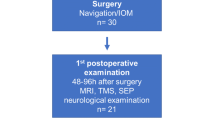Summary.
Background: Intraoperative neurophysiological monitoring has become the standard procedure for locating eloquent regions of the brain. Such continuous electrical stimulation of motor pathways is usually applied by means of flat silicon-embedded electrodes placed directly on the motor cortex. However, shifting of the silicon strip on the cortical surface as well as electrode displacement due to brain shift underneath the electrode can lead to inaccurate recordings not directly caused by intraoperative impairment of the motor cortex or the motor pathways.
Method: This prospective study was conducted to quantify cortical brain shift during open cranial surgery and to assess its impact on electrode positioning in 31 procedures near the precentral gyrus. Three groups of different lesion volumes were distinguished. Movement of the cortex between opening of the dura and completion of tumor removal as well as cortical electrode shifting were digitally measured and analyzed.
Findings: Cortical surface structures evidenced a significantly larger shift (up to 23.4 mm) in comparison to the electrode strips (up to 4.2 mm) in lesions with a volume of over 20 ml. Cortex shifting highly correlated with lesion volume, whereas strip electrode movement was almost unidirectional and did not differ significantly among the three groups. However, the way they were placed (completely on the cortex vs. partly underlying or overlapping the craniotomy borders) affected the magnitude of their intraoperative displacement. As a consequence, 3 of the 31 cases (9.3%) showed a significant change in the recorded motor responses due to intraoperative dislocation of the stimulating electrode.
Interpretation: Changes in the location of cerebral structures due to intraoperative brain shift may exert a marked influence on intraoperative neurophysiological monitoring if cortical strip electrodes are used. Therefore, long-term monitoring of the central region requires continuous checking of the position of stimulating electrodes and, if necessary, correction of their location.
Similar content being viewed by others
Author information
Authors and Affiliations
Additional information
Published online December 5, 2002
Acknowledgments The authors thank Mr. Udo Warschewske and his co-workers of Functional Imaging Technologies (Waltersdorf, Land Brandenburg, Germany) for their help in establishing the software necessary for the navigation-controlled calculation of intraoperative brain and electrode shifting.
Correspondence: Dr. med. Olaf Suess, Department of Neurosurgery, Benjamin Franklin University Hospital, Free University of Berlin, Hindenburgdamm 30, 12200 Berlin, Germany.
Rights and permissions
About this article
Cite this article
Suess, O., Kombos, T., Ciklatekerlio, Ö. et al. Impact of Brain Shift on Intraoperative Neurophysiological Monitoring with Cortical Strip Electrodes. Acta Neurochir (Wien) 144, 1279–1289 (2002). https://doi.org/10.1007/s00701-002-1029-z
Issue Date:
DOI: https://doi.org/10.1007/s00701-002-1029-z




